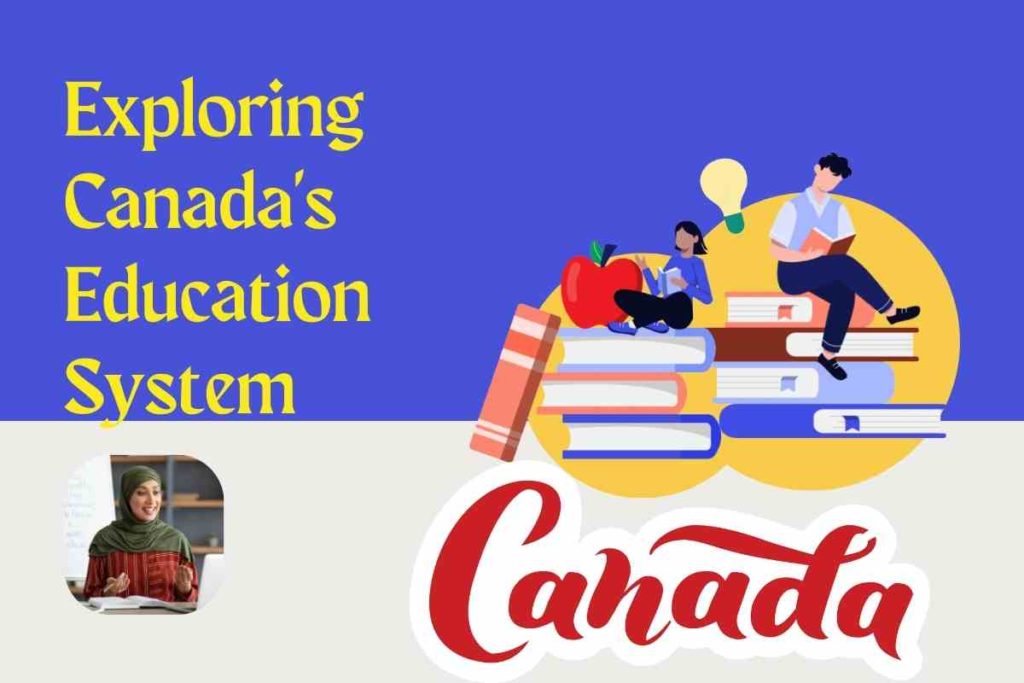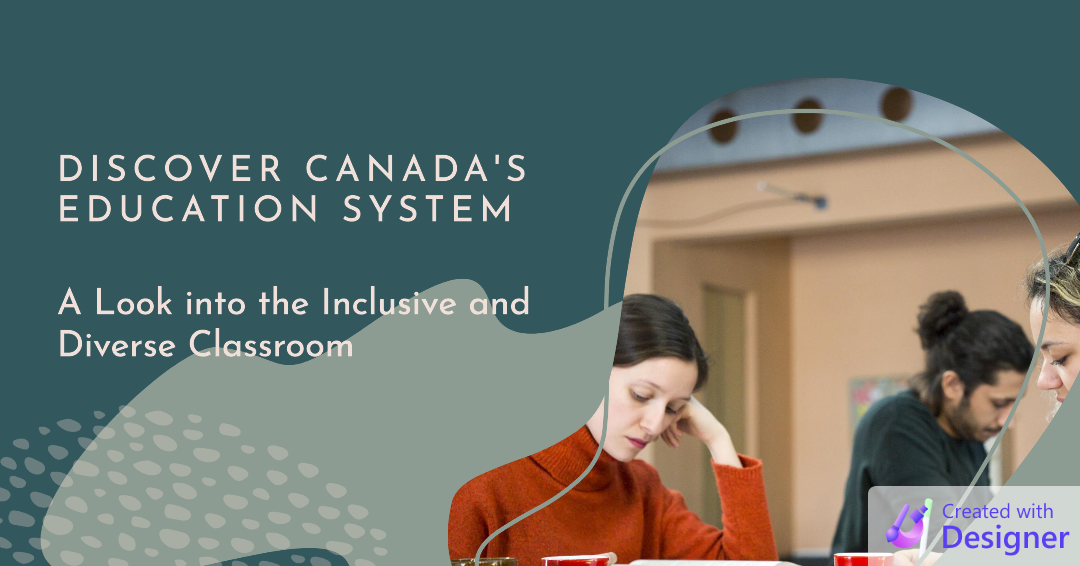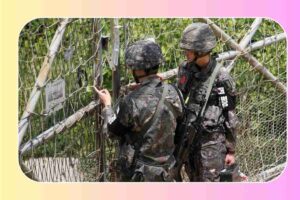Exploring Canada’s Education System

Exploring Canada’s Education System: Canada, often praised for its natural beauty and cultural diversity, boasts an education system that matches its global reputation. With a commitment to inclusivity, quality, and innovation, Canada’s education system is a model for many countries. In this article, we delve into the various aspects of Canada’s education system, exploring its structure, strengths, challenges, and factors contributing to its excellence.
Primary and Secondary Education
Elementary Schools: Building the Foundation
Elementary education in Canada emphasizes foundational skills such as reading, writing, and mathematics. Students receive a well-rounded curriculum, including social studies, science, and arts. The focus is on nurturing curiosity and a love for learning.
Secondary Schools: Preparing for Higher Learning
Secondary education equips students with a broader range of subjects and allows them to explore their interests. The high school years are a stepping stone to post-secondary education, and students can choose between academic and vocational paths.
Post-Secondary Education
Colleges: Practical and Vocational Training
Colleges offer hands-on, practical training for healthcare, technology, and trades careers. They bridge the gap between education and the workforce, producing skilled professionals in high-demand fields.
Universities: Academic Pursuits and Research
Universities are hubs of academic excellence and research. They offer undergraduate and postgraduate programs across diverse disciplines. Many universities are recognized globally for their research contributions.
Inclusivity and Diversity
Embracing Multiculturalism in Education
Canada’s commitment to multiculturalism is reflected in its education system. Schools celebrate cultural diversity and encourage students to appreciate different perspectives. This inclusive environment prepares students for a globalized world.
Addressing Indigenous Education
Efforts are being made to address the historical injustices. Indigenous communities face in education. The curriculum is revised to include Indigenous perspectives and history, fostering reconciliation and understanding.
Quality Assurance and Accreditation
Maintaining High Academic Standards
Canada’s education system is known for its rigorous quality assurance measures. Accreditation bodies ensure that institutions meet predefined standards, safeguarding the value of education.
Role of Provincial and Territorial Authorities
Education governance varies by province and territory. This allows for tailored approaches that align with regional needs while upholding national educational goals.
Innovative Teaching Methods
Blending Technology with Traditional Pedagogy
Educators integrate technology to enhance learning experiences. Blended learning models combine traditional teaching methods with digital tools, catering to diverse learning styles.
Focus on Critical Thinking and Problem-Solving
The curriculum places a strong emphasis on developing critical thinking skills. Students are encouraged to analyze, evaluate, and solve complex problems, preparing them for real-world challenges.
Bilingual Education
The Significance of English and French
Canada’s bilingual identity is celebrated in education. Students can learn in English and French, promoting language skills that are valuable in the global job market.
Advantages and Challenges
While bilingualism offers numerous advantages, challenges such as resource allocation and equitable access to both language streams must be addressed.
Higher Education Funding
Government Support and Tuition Fees
The government subsidises Higher education in Canada, making it more accessible. Tuition fees are comparatively lower than in many other countries, easing the financial burden on students.
Scholarships and Financial Assistance
A range of scholarships, grants, and loans are available to support students financially. These opportunities encourage academic excellence and alleviate financial constraints.
Global Reputation and Attraction
Canada as a Preferred Study Destination
Canada’s reputation as a safe and welcoming country attracts international students. It’s diverse campuses and quality education contribute to a rewarding experience.
Impact on International Students
International students enrich the cultural fabric of Canadian universities. They also contribute to the economy and create lasting global connections.
Challenges and Opportunities
Bridging Gaps in Indigenous Education
Improving Indigenous education includes investing in culturally sensitive teaching materials, supporting Indigenous educators, and fostering community engagement.
Adapting to the Changing Job Market
The education system is evolving to equip students with skills relevant to the modern workforce. Emphasis is placed on technological literacy, adaptability, and lifelong learning.
Education Policy and Governance
Federal vs Provincial Control
Education is primarily a provincial responsibility in Canada. However, the federal government plays a role in funding, research, and promoting educational standards.
Policy Adaptations for Modern Demands
Policies are continually revised to align with the demands of the 21st century. This includes integrating technology, addressing mental health, and promoting inclusive education.
Teacher Training and Professionalism
Rigorous Training Programs
Teacher training programs focus on pedagogical techniques, classroom management, and inclusive teaching practices. Educators are prepared to create engaging and effective learning environments.
Fostering a Culture of Continuous Learning
Teachers are encouraged to pursue professional development throughout their careers. This commitment to growth ensures educators remain current and innovative in their teaching approaches.
Co-Curricular Activities
Holistic Development Through Sports and Arts
Co-curricular activities foster holistic development. Students engage in sports, arts, clubs, and community service, nurturing skills beyond academics.
Building Leadership and Soft Skills
Leadership, teamwork, communication, and problem-solving are honed through co-curricular activities, preparing students for success in various life endeavours.
Education for Sustainability
Integrating Environmental Awareness
Sustainability education instils environmental consciousness in students. They learn about climate change, conservation, and sustainable practices, becoming responsible global citizens.
Promoting Eco-Conscious Citizens
By incorporating sustainability into the curriculum, Canada’s education system equips students with the knowledge and motivation to address pressing environmental challenges.
Parental and Community Involvement
Importance of Engaged Families
Parental involvement is encouraged at all educational levels. Collaborative efforts between schools, parents, and communities contribute to student success and well-being.
Collaborative Efforts for Student Success
Schools actively engage with communities to create a supportive learning environment. Partnerships with local organizations enhance resources and opportunities for students.
Conclusion
In conclusion, Canada’s education system is a testament to the nation’s commitment to nurturing well-rounded individuals equipped for success in a dynamic world. Canada prepares its students to become informed, empathetic, and active global citizens through its inclusive policies, innovative teaching methods, and dedication to quality.
Frequently Asked Questions
- Is education free in Canada? Education in Canada is subsidized, resulting in lower tuition fees than many other countries. However, there are still costs associated with attending school.
- Are international students welcomed in Canada’s education system? Yes, Canada is known for its welcoming attitude toward international students. They contribute to the cultural diversity of campuses and the country.
- How does Canada address Indigenous education? Canada is addressing historical inequalities in Indigenous education by incorporating Indigenous perspectives into the curriculum and investing in Indigenous-led initiatives.
- What is the role of provinces in education governance? Provinces and territories have the authority to govern education within their jurisdictions, allowing for tailored approaches that meet regional needs.
-
Are teachers well-trained in Canada? Yes, teachers undergo rigorous training programs that prepare them for effective teaching, inclusive practices, and continuous professional development.








